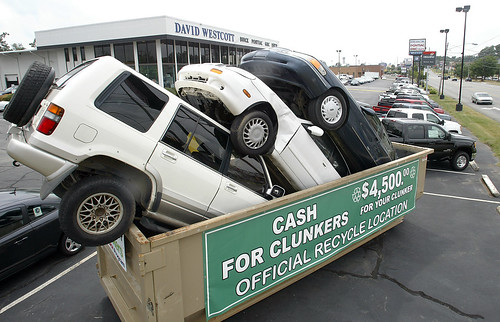Do Your Bit to Reverse Climate Change Today! Blog Action Day 2009 – October 15, 2009

One of my favorite websites for all things Social Media, Mashable.com, got my attention today with their blog post about the Blog Action Day. Today (October 15, 2009) is the third annual Blog Action Day, a yearly event in which thousands of blogs around the web pledge to write about a single global issue in an effort to focus global attention.
Two years ago, the inaugural Blog Action Day tackled the environment, last year blogs across the world wrote about poverty, and this year over 8,800 blogs from 148 countries are uniting today to write about an issue of global importance: climate change.
You may ask what difference does it make by simply dropping a blog post on Climate Change? The possibilities are endless..Your one post can inspire someone else to write about this issue..The more people write about, the more people will get to read, and thus we create an awareness about the on going problem.. In the cacophony of today’s world, too many people have no time to even stop and think about this very important issue that threatens our very existence on this planet. If your blog can divert the attention of someone – a friend on Facebook, or a random reader from Timbuktu who has subscribed to your blog’s RSS – even for a moment and make them think how they have contributed to this generations effort to save the planet, you have done your bit. Trust me — that’s how we all make a difference in this world – in our own little ways.
For me there is a bit more close to heart on this issue. Being a transportation engineer/nerd/nut/practitioner/wonk, etc, etc, I’ve first hand knowledge about the impact of fossil fuels on our planet. In 2006, the world used 3.9 billion tons of oil. Fossil fuel usage in 2005 produced 7.6 billion tons of carbon emissions, and atmospheric concentrations of carbon dioxide reached 380 parts per million. These numbers have continued to rise over the years and is expected to grow rapidly unless we curb the use of fossil fuels.
So what have I done personally towards mitigating this growing threat of Climate Change?
- First, I made some lifestyle choices that have immensely reduced my carbon footprint. It all started with moving to a house that’s closer to a train station. Now I take transit (trains and buses) to work and walk a lot when I don’t have these options.
- These days I drive a maximum of 20 miles in a whole week (primarily for groceries & other routine errands that I need to do on weekends). Just by doing that, I not only reduced my fuel consumption (which directly contributes to the reduction in Green House Gases which other wise may have come from my driving) but also saved a bunch of money on car insurance. Now seriously thinking about going the “ZipCar” way, which means no insurance charges at all.
- I started making it a habit to car pool if I know I am going to be in a place with some of my friends.
- Starting to schedule my networking events (Happy Hours, Meetings, etc) at locations that are closer to the Metro rail stations. (Hey, that way I can have an extra drink without having to worry about getting a DUI or DWI).
- I encourage people in my network to think about leaving their darned cars at home at least for a day at work.
- I recycle like crazy these days.
- Stopped buying bottled water. PERIOD.
- Stopped using plastic spoons, knives and forks as much as I can.
- Buying products that are environmentally friendly (biodegradable). I’m very determined to not buy products from companies that are not supportive of environmental initiatives (Here I must applaud Apple & Nike for sticking to their stands on the going green initiatives and walking away from the US Chamber of Commerce).
- Hmmm..What else? Ah, I encourage myself to publish more articles that talk about the various environmental initiatives related to transportation here on Transportgooru.com.
I already hear some of you growling that all these are possible because I live in an urban area or because I have a choice to do so due to my socio-economic status. I agree with you – only to a degree. Location matters only on issues such as transportation. For the rest of the stuff to happen, I have to personally feel the need to do them. I feel the urgency to act NOW and not tomorrow or the day after. We already have a lot of grim news about how fast we are spiraling downwards into a horrible environmental mess, thanks to the mainstream media and the awesome social media networks. For example, today there was a report on the possibility of no ice cover in the Arctic region by 2030.
Every generation had its challenge and they stood up to address them issues when they were called into action (World Wars, Pandemic Diseases, Natural Disasters, etc). For our generation, I consider the Climate Change as the biggest challenge and truly believe that we will stand together and fight this battle to save this planet. Someday in the future I do not want to hear the children and grandchildren tell us “Your generation screwed us royally by plundering the earth and ignored all the warning signs”. Here I am doing my little bit, trying to make a difference and I hope you will join me in this fight to preserve the Earth that we all call HOME. Now, you can go blog about your little bit if you already have a blog or a website. If you don’t have one, I encourage you to start one and start talking about how you want to save this planet. If you can’t do that, at least go change your light bulbs to something that is more energy efficient or recycle that trash that you have piled up in the corner of your basement. Oh, if you are a US citizen, write to your congressman/congresswoman/Sentor telling them how you want the US to contribute towards the Climate Change efforts during the upcoming UN Climate Change Conference in Copenhagen (December 2009) . Just do your little bit, that’s all.
Click here to read more and Click here to Take Action.







